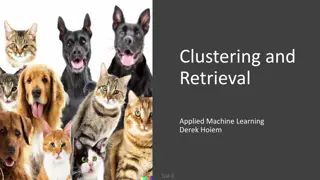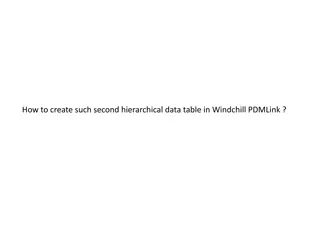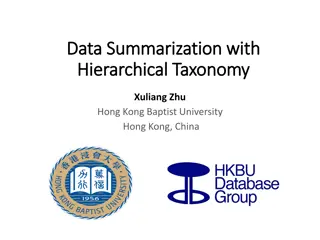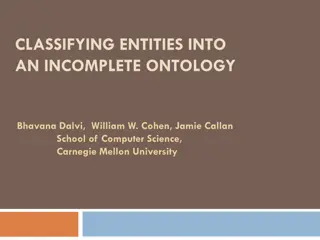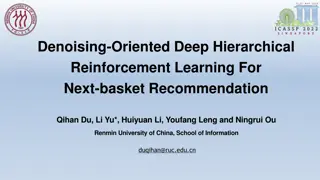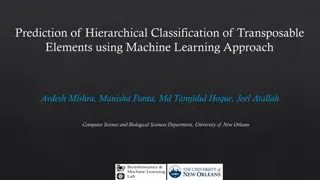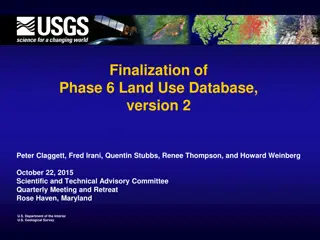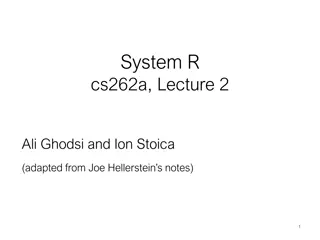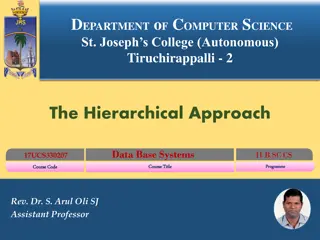Prioritizing Clinically Important Outcomes Using Hierarchical Win Ratio
Clinical trials often use composite outcomes, but conventional analysis methods have limitations in accurately reflecting clinical reality. Hierarchical outcomes offer flexibility by defining a hierarchy of events based on importance. Analyzing trials using hierarchical outcomes involves comparing p
19 views • 20 slides
Clustering Algorithms: K-means and Hierarchical Clustering
Explore the concepts of clustering and retrieval in machine learning, focusing on K-means and Hierarchical Clustering algorithms. Learn how clustering assigns labels to data points based on similarities, facilitates data organization without labels, and enables trend discovery and predictions throug
1 views • 48 slides
Design and Evaluation of Hierarchical Rings with Deflection Routing
This research explores the implementation of Hierarchical Rings with Deflection (HiRD) routing as a solution to the performance and energy inefficiencies found in traditional hierarchical ring designs. HiRD guarantees livelock freedom and efficient delivery while simplifying the network structure by
1 views • 52 slides
Creating Second Hierarchical Data Table in Windchill PDMLink
Learn how to set up a second hierarchical data table in Windchill PDMLink by selecting rows from the first table to view and interact with related objects in a structured manner. The process involves customization and user actions within the tables to manage parts and documents efficiently.
0 views • 8 slides
Hierarchical Attention Transfer Network for Cross-domain Sentiment Classification
A study conducted by Zheng Li, Ying Wei, Yu Zhang, and Qiang Yang from the Hong Kong University of Science and Technology on utilizing a Hierarchical Attention Transfer Network for Cross-domain Sentiment Classification. The research focuses on sentiment classification testing data of books, training
1 views • 28 slides
Data Summarization with Hierarchical Taxonomy: Motivations and Examples
The research discusses the use of Hierarchical DAGs in summarizing data with a focus on disease ontology and animal diseases. It explores how general concepts can summarize specific items and their relationships. The study also presents motivated examples of popular papers summarization in SIGMOD, s
2 views • 27 slides
Classifying Entities into an Incomplete Ontology: Exploratory EM Approach
The research discusses methods for hierarchical classification of entities into incomplete ontologies. It explores the challenges of evolving web-scale datasets and the need for classifying entities in an incomplete ontology structure. The Hierarchical Exploratory EM model is detailed, providing ins
5 views • 27 slides
Denoising-Oriented Deep Hierarchical Reinforcement Learning for Next-basket Recommendation
This research paper presents a novel approach, HRL4Ba, for Next-basket Recommendation (NBR) by addressing the challenge of guiding recommendations based on historical baskets that may contain noise products. The proposed Hierarchical Reinforcement Learning framework incorporates dynamic context mode
2 views • 16 slides
Hierarchical Semi-Supervised Classification with Incomplete Class Hierarchies
This research explores the challenges and solutions in semi-supervised entity classification within incomplete class hierarchies. It addresses issues related to food, animals, vegetables, mammals, reptiles, and fruits, presenting an optimized divide-and-conquer strategy. The goal is to achieve semi-
6 views • 18 slides
Efficient and Effective Duplicate Detection in Hierarchical Data
This study explores the efficient and effective detection of duplicates in hierarchical data, focusing on fuzzy duplicates and hierarchical relationships in XML. It discusses the current and proposed systems, including the use of Bayesian networks for similarity computations. The methods involve vec
1 views • 25 slides
Hierarchical vs. Non-Hierarchical Models in Computer Graphics
Dive into the concepts of hierarchical and non-hierarchical modeling in computer graphics. Explore how hierarchical models represent complex objects with explicit sub-part dependencies, while non-hierarchical models treat objects independently. Understand the benefits and challenges of each approach
3 views • 30 slides
Machine Learning Approach for Hierarchical Classification of Transposable Elements
This study presents a machine learning approach for the hierarchical classification of transposable elements (TEs) based on pre-annotated DNA sequences. The research includes data collection, feature extraction using k-mers, and classification approaches. Proper categorization of TEs is crucial for
1 views • 18 slides
Improved Hierarchical Word Sequence Language Model Using Word Association
This research presents an enhanced hierarchical word sequence language model leveraging word association techniques. It explores the motivation behind the model, smoothing techniques for data sparsity, and the basic idea of the proposed approach, focusing on patterns and word generation. The propose
0 views • 21 slides
Hierarchical Clustering
- Hierarchical clustering is a versatile technique in data mining that creates a hierarchical decomposition of objects based on similarity or distance measures. This clustering method offers insights into data relationships through dendrograms, allowing for the identification of outliers and the exp
3 views • 36 slides
Finalization of Land Use Database Phase 6 Version 2
The finalization of Phase 6 Land Use Database, version 2, involved merging local and regional land use datasets, implementing hierarchical rules to reconcile datasets, summarizing land uses within Federal Macro-agency parcels, estimating impervious and turf grass acres, incorporating Maryland data,
3 views • 13 slides
Hierarchical Routing in Computer Networks
Hierarchical routing in computer networks involves organizing routers into regions known as autonomous systems (AS). This approach enables efficient routing by aggregating routers and allowing different AS to run their own intra-AS routing protocols. Interconnected ASes utilize both intra- and inter
0 views • 25 slides
Verifiable Hierarchical Protocols with Network Invariants
This research discusses the design and automated verification of hierarchical protocols with an emphasis on network invariants. The study presents a solution tailored for asymmetry in hierarchical systems by utilizing specific automated techniques and formally specifying transition systems. Key comp
3 views • 33 slides
Database Management Systems: Understanding Hierarchical Models in Databases
Explore the fundamentals of databases storing information, including records, connections, and searching methods. Delve into the hierarchical model exemplified by department and employee data, illustrating how to locate and retrieve specific information efficiently within a structure. Discover the s
2 views • 75 slides
Design and Evaluation of Hierarchical Rings with Deflection Routing
This study presents the HiRD solution, a hierarchical ring design with deflection routing that enhances performance and energy efficiency while simplifying the network structure compared to traditional designs. The research highlights the scalability issues in ring-based NoCs and introduces an effec
2 views • 52 slides
Hierarchical Modulation for Improved WLAN Connectivity
Explore the innovative Hierarchical Modulation (HM) proposal by Samsung for IEEE 802.11, aiming to enhance reliability and reduce latency in WLAN connectivity under interference scenarios. The concept involves modulating high and low priority data streams into a single symbol stream, providing bette
1 views • 17 slides
Capsule Network for Multi-Label Image Classification Study
Explore a Capsule Network for Hierarchical Multi-Label Image Classification through a detailed analysis of classification approaches, hierarchical structure, and CapsNet models. This study delves into Class Taxonomy, Hierarchical Classifiers, CNN-Based Classifiers, and Capsule Networks' innovative f
1 views • 19 slides
Hierarchical vs. Relational Database Management Systems: A Comprehensive Overview
Explore the fundamental concepts of databases, including Hierarchical and Relational Database Management Systems. Understand the role of a Database Management System (DBMS) in storing and retrieving data efficiently. Delve into the history and evolution of DBMS, from its inception by Charles Bachman
0 views • 62 slides
Cluster Analysis in Predictive Analytics for Economists
Explore the world of Cluster Analysis in the context of predictive analytics for economists. Understand its significance, applications, and best practices in customer segmentation and more. Learn about Hierarchical and Non-Hierarchical Clustering approaches for effective data grouping.
0 views • 18 slides
Database Modeling: Hierarchical, Network, and Entity Relationship Models
Explore different database modeling concepts including hierarchical, network, and entity-relationship models. Learn how data is organized, relationships are established, and how entity-relationship diagrams visually represent database structures.
1 views • 9 slides
Data Modeling: Entity Relationship, Relational, Hierarchical, and Network Models
Explore the world of data modeling through Entity Relationship, Relational, Hierarchical, and Network Models. Learn about entities, attributes, relationships, tables, hierarchies, and schema design in a database. Dive into the basics of data organization and structure for effective database manageme
0 views • 6 slides
Text Classification and Clustering Methods Overview
Explore text classification and clustering methods in this comprehensive lecture covering topics such as supervised vs. unsupervised learning, clustering techniques, similarity measurement, and more. Understand the difference between soft and hard clustering, hierarchical vs. non-hierarchical cluste
3 views • 19 slides
Data Models and History: Hierarchical, Network, Relational, and Declarative
This content covers various data models including hierarchical, network, and relational, discussing concepts such as data redundancy, physical and logical data independence, and relational algebra. It also provides examples of zoo data models, tables, and complex queries related to animals and cages
3 views • 31 slides
Hierarchical Clustering Analysis for Data Mining
Explore hierarchical clustering analysis in data mining including agglomerative and divisive methods, dendrogram visualization, distance measures, and cluster merging techniques. Learn how to group data objects into a tree of clusters for effective data analysis and insights.
1 views • 47 slides
Hierarchical Clustering and Cluster Distance Measurements
Explore different types of hierarchical clustering methods and learn about measuring distances between clusters. Discover the elements of statistical learning and data structures of mapper1D output. Visualize cluster adjacency and vertex levels in cluster analysis.
0 views • 20 slides
Hierarchical Mesh Tree Routing Proposal for IEEE P802.15-14-0536-00-0010
This document presents a comprehensive proposal for Hierarchical Mesh Tree (HMT) routing in the IEEE P802.15 Working Group for Wireless Personal Area Networks (WPANs). The submission encompasses the construction, maintenance, and update of the HMT, with a focus on routing strategies based on link qu
3 views • 58 slides
Class Inheritance and Hierarchical Inheritance in Object-Oriented Programming
Learn about the concepts of class inheritance and hierarchical inheritance in object-oriented programming. Explore how inheritance creates relationships between classes, allows for the creation of new classes based on existing ones, and defines the accessibility of base class members in derived clas
2 views • 56 slides
Hierarchical Model in Database Management Systems
Explore the concept of hierarchical models in database management systems, focusing on Department 17's employee structure. Learn how to find all employees in Department 17 through hierarchical relationships. Discover the historical relevance of IMS in managing inventory for space vehicles.
2 views • 62 slides
Hierarchical Modulation for IEEE 802.11: Initial Results and Findings
Explore the analytical results and discussions on Hierarchical Modulation for IEEE 802.11 in March 2024. Discover insights on BER for SISO systems with uncoded Hierarchical Modulation using 16QAM and 64QAM. Gain an understanding of modulation parameters and robustness levels for different constellat
0 views • 10 slides
Understanding Data Models in Database Management Systems
Explore the objectives, types, and advantages of data models in database management systems. Learn about hierarchical and network models, their structures, and how they organize data efficiently for various users. Understand the advantages and disadvantages of hierarchical models in managing data ef
3 views • 18 slides
Understanding Hierarchical Linear Modeling (HLM) for Educational Analysis
Explore the concept of Hierarchical Linear Modeling (HLM) in educational research, including the challenges of analyzing hierarchical data structures, nested data examples, and the problematic nature of ignoring nesting. Learn how modeling the hierarchical structure can lead to improved estimation o
0 views • 12 slides
Unlocking Advanced Techniques for Hierarchical Models
Dive into the world of hierarchical models with this comprehensive introduction to XYZ. Explore the importance, application domains, datasets, and results of these cutting-edge techniques. Discover why mastering hierarchical models is crucial and delve into the wealth of information this resource pr
0 views • 5 slides
Streamlining Hierarchical Facets Implementation at VuFind Summit 2023
Discover how VuFind has simplified hierarchical facets implementation since 2014, moving away from jsTree to a more efficient HTML-based approach. This change has led to significantly less code to maintain, simpler loading of facet data, and fewer AJAX and Solr requests. Explore the evolution from c
2 views • 6 slides
Hierarchical Clustering Techniques
Learn about Hierarchical Clustering, a popular method for grouping data points into nested clusters. Understand the Agglomerative Clustering Algorithm, starting and intermediate situations, merging clusters, and defining inter-cluster similarity in hierarchical clustering.
3 views • 26 slides
Silhouette Analysis & Hierarchical Clustering in Machine Learning
Explore the concept of Silhouette Analysis for evaluating clustering quality and the methodology of Hierarchical Clustering in machine learning. Understand types of Hierarchical Clustering such as Agglomerative approach, linkage criteria, Ward's Method, and Dendrogram visualization. Discover real-wo
6 views • 8 slides
Understanding Hierarchical Predictive Coding Models
Explore the concepts of Bayesian hierarchical models and hierarchical predictive coding, with a focus on predictive coding in the sensory cortex. Dive into the computational transformations and neural activity patterns associated with these models, providing insights into hierarchical information pr
1 views • 4 slides

